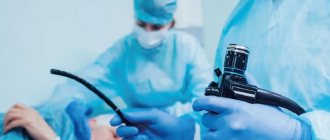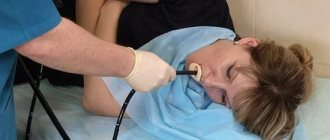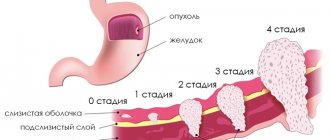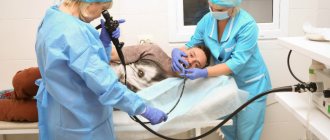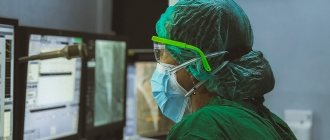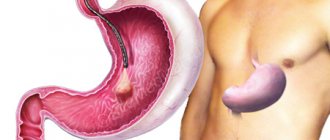FGDS (fibrogastroduodenoscopy) is an endoscopic examination of the esophagus, stomach and duodenum using fiber optics (probe, gastroscope, endoscope). This diagnostic method is very accurate and effective; it allows you not only to see organs from the inside, but also makes it possible to take a tissue sample.
Many people are very afraid of this procedure. But in fact, everything is not so scary if you properly prepare for the FGDS.
How is gastroscopy performed?
The procedure for gastroscopy of the stomach is as follows:
- First, the doctor treats the patient's larynx with an anesthetic ( lidocaine ). This will help reduce the gag reflex and reduce discomfort in the throat. In some cases, the patient is sedated or anesthesia is used.
- Next, the patient is placed on his left side, and a mouthpiece is inserted into the mouth. This will prevent the jaw from clenching and interfering with the procedure.
- A gastroscope is pulled through the hole in the mouthpiece. The patient is asked to take a deep breath. At this point, the doctor inserts a tube into the esophagus.
- When the camera located at the end of the tube reaches the stomach, the doctor begins the examination. If necessary, takes a mucosal biopsy.
- At the end of the examination, the probe is carefully pulled out.
In some cases, the patient undergoes transanasal gastroscopy. Its main difference is that the tube is inserted not through the mouth, but through the nose.
Basic Rules
Proper breathing during gastric gastroscopy will facilitate the advancement of the gastroscope and make it less uncomfortable. In addition, it will help reduce the risk of damage to the walls of the esophagus and stomach, and also minimize pain.
Basic Rules:
- you need to breathe through your nose ;
- inhale and exhale as deeply as possible;
- take your time, breathe slowly;
- involve the stomach, not the chest, in the process;
- move as little as possible.
Important Do not try to swallow saliva or make swallowing movements while moving the gastroscope into the stomach - this can lead to injury to the walls of the larynx by the endoscope.
Belching may also occur during the procedure. There is no need to be ashamed of this: getting rid of air in the stomach will have a positive effect on the procedure.
The more relaxed you are during the procedure, the faster the doctor will be able to examine the gastrointestinal tract and the less you will damage the mucous membrane. If the mucous membrane in the throat is damaged, it can become infected and you may have a sore throat after the procedure.
Preparation
If the patient is worried about the upcoming procedure, he can practice proper breathing at home.
To do this you need:
- Find a quiet place where you can be alone.
- Position yourself on your left side.
- Insert any object resembling a mouthpiece between the upper and lower jaws.
- In this position, take a deep breath through your nose, while drawing in your stomach.
- Exhale through the nose, completely relaxing the abdominal muscles.
- Try not to worry or think about anything distracting at this moment.
The duration of the workout should be at least 5-10 minutes. If it is difficult to cope with anxiety even at home, the training time can start from 1 minute and gradually increase it.
Where can I find the courage to make up my mind? Gastroscopy – WITHOUT fear!
Please note: any invasive procedure in medicine is accompanied by risks. An invasive procedure (from the New Latin invasivus; from invado - “I go inside”) is a medical procedure associated with penetration through the natural external barriers of the body (skin, mucous membranes, etc.). According to ORDER No. 974n dated December 6, 2022 ON THE APPROVAL OF RULES FOR CONDUCTING ENDOSCOPIC STUDIES, endoscopic studies are carried out on the direction of the attending physician or paramedic, midwife if they are assigned certain functions of the attending physician, taking into account the patient’s right to choose a medical organization. That is why we focus on the indications and contraindications for this study, and options for alternative methods.
Once upon a time, going to the dentist was an extraordinary event. The reason was simple: anticipation of pain. Times have changed and there is no need to be afraid anymore. Medical technology has made great strides, allowing patients to leave fear in the past. However, even today there are still procedures that a person approaches with some anxiety, putting off going to the doctor. But are his fears justified?
Today we are talking about gastroscopy. In order to dispel the fears of our readers, we went to an appointment with our consultant, endoscopist at Clinic Expert Kursk LLC, Yulia Nikolaevna Kalinina. The article will be useful both to those who ask themselves the question “I’m afraid of gastroscopy - what to do?”, and to those who are not afraid of the procedure, but want to understand its features.
- Yulia Nikolaevna, in the minds of many, gastroscopy is associated, if not with torture, then with terrible discomfort - for sure. Is this diagnostic procedure really for the bravest?
This is wrong. When impressions of the diagnosis transferred from person to person, over time the information acquires a somewhat exaggerated emotional coloring. Therefore, with the question “Is it scary to do a gastroscopy or not,” it is better to contact the doctor with whom you are going to undergo the study in advance.
- Does gastroscopy have any other name or names?
Yes. These are fibrogastroduodenoscopy (FGDS), esophagogastroduodenoscopy (EGDS), video esophagogastroduodenoscopy (VEGDS).
- How is gastroscopy of the stomach performed and what does it reveal?
Most often in a lying position on the left side. An endoscope is passed through the mouth into the esophagus and further. With its help, the upper parts of the digestive tract are examined: the esophagus, stomach and part of the duodenum. In this case, the presence of inflammatory processes, erosions and ulcers, benign and malignant neoplasms of the mucous membrane is determined.
Much less often, but still there are pathological formations located not on the mucous membrane, but under it, in the thickness of the stomach wall. In this case, it is difficult and sometimes impossible to directly evaluate them. For such cases, there are endoscopic devices that have an ultrasound attachment, which allows you to perform an ultrasound of the wall of the organ being examined directly from the inside, and also, if necessary, take a biopsy from any suspicious formation. These devices, as a rule, are much more expensive than conventional ones and are not available in every medical institution.
- In what cases is gastroscopy indispensable? When is it appointed?
Indications for this diagnosis are pain in the upper abdomen, periodic nausea or vomiting, weight loss not related to any special diet, bad breath, heartburn, a sour or bitter feeling in the mouth, as well as preventive purpose (if first-degree relatives had or have diseases of the upper parts of the digestive system).
- Does gastroscopy have any contraindications?
Yes. Among them: the agonal state of the patient, heart attacks and strokes in the acute and subacute period, mental disorders and some others.
Risk groups and factors for gastroscopy may include old age, heart failure of a certain severity, serious pulmonary pathology and some others.
The question of the possibility of conducting an examination is decided in each specific case, based on the patient’s clinical picture.
— Yulia Nikolaevna, is it possible to perform gastroscopy without swallowing the probe? Are there alternative methods?
It is forbidden. In addition, the use of the name "probe" in relation to gastroscopy is incorrect. A probe is an independent device with its own purpose.
Alternative research methods certainly exist. This is an X-ray examination of the stomach with a barium suspension. This method in general is significantly inferior to endoscopy in diagnostic power, however, in particular, it can help, for example, when a more detailed study of the contractile function of the stomach is required. In this aspect, it will be more informative than endoscopy, and, when used according to indications, can help in making a diagnosis, including some forms of stomach cancer.
Another method is capsule endoscopy. Initially, the method was created to examine more distant parts of the intestine that cannot be examined using traditional endoscopy. With the latter, the stomach is inflated with air during the examination in order to examine the entire area of the mucous membrane. With capsule endoscopy, this cannot be done and, in addition, the capsule cannot be controlled during the examination, like a traditional endoscope.
Thus, at the moment in the development of medical science and technology, there is not a single research method that could be fully comparable or superior to endoscopy in terms of completeness and diagnostic accuracy.
- Does it make sense to do gastroscopy under anesthesia?
If necessary, of course, since the main task is to conduct a full diagnosis.
The reality is that, due to individual psycho-emotional characteristics, not every patient is psychologically and physically ready for this procedure, so sometimes gastroscopy under anesthesia is the solution.
- Does gastroscopy without anesthesia require the patient to strictly follow the doctor’s instructions? For example, how should you breathe during FGDS - through your mouth or nose?
Yes, you need to stick to what the doctor says. There is no fundamental difference between breathing through the mouth or nose - the main thing is to breathe calmly. We always teach our patients what to do and how to do it, and help them throughout the entire procedure.
- How to properly prepare for gastroscopy of the stomach? Is special nutrition necessary before the examination?
If the procedure is planned for the first half of the next day, you should not eat after 7 pm the day before. Dinner should be light, without fermented milk, spicy, smoked or salty foods. You can drink it in the evening of this day.
No special nutrition is required before preparing for the procedure of examining the stomach using FGDS. On the day of the test you should not smoke, chew gum or drink. If your mouth gets dry, you can rinse it, but do not swallow water.
- Any coin has two sides, so the question of negative consequences is natural. Can there be any complications after the diagnosis?
We are not even talking about complications, but rather about discomfort. Immediately after the procedure, there may be slight colic in the abdomen due to the movement of air, which is used during the examination to inflate the stomach and may enter the intestines in some quantity. They disappear within a few minutes after the procedure.
There may be a feeling of rawness and pain in the throat for 1-2 days after the examination.
- How often can I have this examination?
As often as required for each specific clinical situation. This is determined by the attending physician, depending on the diagnosis. Frequent regimens for example: 1 month after the initial diagnosis and treatment, once every six months for autumn-spring exacerbations of gastric and duodenal ulcers, once a year for gastritis.
- Yulia Nikolaevna, what would you wish for those who need to undergo gastroscopy, but fear is stopping them?
I would like to wish our readers to trust the doctor who will conduct the study. To do this, you can, for example, go and talk to him in advance. The study is not nearly as unpleasant and scary as it is described and imagined. Therefore, be calm and come to the examination without fear.
Other interviews with Kalinina Yu.N.:
Colonoscopy of the intestines - is it scary?
For reference:
Kalinina Yulia Nikolaevna
Graduate of the Faculty of Medicine of Kursk State Medical University in 2009.
From 2009 to 2011 she completed clinical residency in the specialty “General Surgery”.
In 2011 - specialization in endoscopy.
Since 2015, he has been working as an endoscopist at Clinic Expert Kursk LLC.
Breathing techniques
#1 – Call on the parasympathetic nervous system!
The parasympathetic system helps restore spent energy reserves and regulates the functioning of the body during sleep.
You can summon it with the help of breathing - short inhalation, slow exhalation. This technique will help you relax while inserting the endoscope into the oral cavity:
- We take a short breath through the nose to the count of 1 and 2.
- On the count of 3,4,5,6, we exhale slowly through the nose.
- Counting in your head will allow you to take your mind off a stressful situation and control your breathing.
- Try to track your breathing during the procedure and control it. And you won’t notice how the procedure ends!
Exhaling slowly helps slow your heart rate, which also creates a feeling of calm.
No. 2 – Square of Calm
Another technique to help you calm down. Its advantages are that it is performed in a few minutes and can be used not only during the insertion of the probe, but also before the procedure.
- You should start by taking a deep, leisurely breath through your nose. Mentally, a square appears before your eyes. The gaze turns to its lower left corner and moves towards the upper left corner for 4 seconds.
- Then we hold our breath and draw a horizontal line from the upper left corner to the right. We count down 4 seconds.
- We exhale for 4 seconds and look vertically from the upper right corner to the lower.
- And we finish drawing the square with our eyes for 4 seconds while holding our breath.
- Can be repeated throughout the entire procedure. If you do this exercise before the procedure. Drawing 5 squares is enough.
#3 – A place where I won’t be disturbed
Visualization of images helps to get rid of stress during FGDS and drive away bad thoughts. By creating an imaginary picture in your mind, you can go to a calm place and “wait out” the unpleasant procedure there.
Technique:
- To begin, close your eyes and inhale deeply through your nose, feeling your lungs fill with air.
- Next, without opening your eyes, you need to imagine yourself in any pleasant place, for example, in a forest grove, on the ocean shore or in the cozy living room of your own apartment.
- For better visualization, you need to use as many senses as possible: try to catch an imaginary smell, hear the sound of the surf, the rustle of leaves, feel the blow of the wind.
- During the procedure, you should concentrate as much as possible on the sensations created, while not forgetting to follow the doctor’s instructions.
Preparation for FGDS
Proper preparation for EGD of the stomach includes following a diet, fasting before the procedure itself, as well as mental preparation. First things first:
Diet to prepare for FGDS
Two days before the diagnosis, it is recommended to limit yourself to heavy and gas-producing foods. Should be excluded from the diet:
- alcoholic drinks;
- chocolate;
- spicy food;
- nuts;
- fat meat;
- legumes; (lentils, peas, etc.)
- mushrooms;
- fast food;
- smoked meats;
- etc.
The stomach may simply not have time to clear itself from a heavy meal, which will worsen the results of the study (it is unlikely that you will want to go through the procedure again).
What can you eat in preparation for EGD of the stomach?
You need to eat foods that are easy to digest, for example:
- boiled chicken breast;
- lean fish;
- buckwheat or rice;
- light soups;
- eggs;
- fermented milk products (low-fat);
- vegetables after heat treatment.
How many hours before FGDS should you not eat?
The last meal should be 10-12 hours before diagnosis, therefore, when preparing for FGDS of the stomach in the first half of the day (and usually the appointment is prescribed in the morning), it is better to have dinner approximately 3-4 hours before bedtime.
When preparing for FGDS in the afternoon, you still need to maintain an interval of 10-12 hours, so calculate the time of your last meal yourself (perhaps it will be early in the morning).
Is it possible to drink water before FGDS?
You can drink water up to two hours before the procedure. Strong tea, coffee, and carbonated drinks should be excluded.
How long after FGDS can you eat?
You can eat after two hours. We recommend eating a light meal on the day of the examination.
What else should not be done before FGDS:
- smoke;
- take medication;
- chew gum;
- brush your teeth (paste may get inside and cause irritation);
- You should not undergo FGDS if you are unwell (runny nose, fever - it is better to wait for recovery);
- FGDS should not be done for laryngitis, pharyngitis, tracheitis (swelling of the mucous membrane interferes, it becomes sensitive to the mechanical effects of the endoscope).
You should also notify your doctor if you have chronic pathologies, allergies to medications, or difficulties with nasal breathing.
Preparation for FGDS under anesthesia:
The examination is carried out under anesthesia, if there are medical indications. The rules for preparing for FGDS are the same; they also include taking blood tests and avoiding iron-containing and non-steroidal anti-inflammatory drugs.
Is it possible for pregnant women to do FGDS:
Gastroscopy is safe for pregnant women as well; there are no contraindications. The only thing that the procedure can cause is a little stress.
